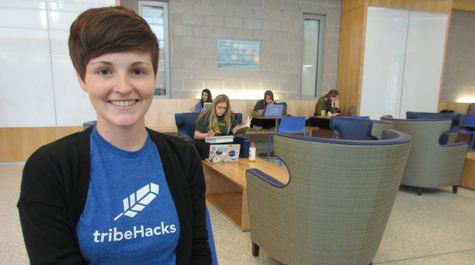TribeHacks, the 32-hour coding marathon, returns to William & Mary
TribeHacks, William & Mary’s annual student-run coding marathon, will move back to Swem Library, the venue of the very first event.
Eryn Sawyer ’17 says registration is open for the March 31-April 2 event. Sawyer is the lead organizer for TribeHacks III, heading a committee whose members include Richard Bonett ‘17, Michelle Brown ‘17, Philip He ‘18, Dan Jelf ‘18, Bery Montenegro ‘18, Nathan Owen '17 and Will Theuer '17. The event is sanctioned by Major League Hacking, the official body of college hackathons.
Game designer, director and producer Todd Howard '93 will give the TribeHacks III keynote address at 4 p.m. on March 31 in Commonwealth Auditorium. Howard is associated with Bethesda Game Studios and has received a number of industry honors including being a member of the Academy of Interactive Arts and Sciences Hall of Fame. He will speak on “Digital Escapes: Our Journey in Digital Creation and Consumption.”
“We're very excited to have him locked in for our keynote,” Sawyer said. “While he won't be on campus long, we're hoping to build on the hype by offering a tutorial on how to make a basic video game during TribeHacks.”
The 32-hour marathon event is open to all college students and anyone who has received an undergraduate degree in the past year. A substantial portion of TribeHacks attendees come from other schools.
Hackers usually work in teams on hacks that are often apps. But not always: TribeHacks II had drone hacks and even a hacked wah-wah pedal for an electric guitar.
Members of William & Mary’s student chapter of the Association of Computing Machinery have traditionally taken on the duties involved in organizing and hosting the university’s annual hackathon. Sawyer was an organizer at TribeHacks II last year, serving as webmaster. She says there’s a lot of work involved in setting up and running a hackathon, but it’s all worth it.
“It really exposes the computer science community at William & Mary to students at other schools,” Sawyer said. “Those students may have different experiences or have taken different classes. They may not even be computer science majors. Maybe they’re working on a data science major or something.”
One of the priorities of hackathon organizers is securing sponsors. Sawyer and her team have locked in four sponsors — Dominion Enterprises, CGI, Agile Software and Booz Allen Hamilton. They’re working on securing additional sponsors. Sawyer noted that sponsors not only provide financial and in-kind support, but also bring inspiration to a hackathon.
“We look for someone who would be interested in posing a challenge to our participants,” she said. Sawyer explained that many sponsors send representatives to hackathons with specific app requests. Often, the sponsor will offer a prize to the best solution to their need.
“That gives the newer attendees an entry point. They say ‘Oh, here is a clearly defined goal,’” she explained.
In addition to the ad hoc prizes offered by sponsors, each hackathon has a set of prizes awarded by judges. Rules indicate that all hacks must be begun during the event itself, so it’s not unusual for incomplete work to be submitted for judging.
Sawyer said the judges have to weigh competing factors — coolness versus utility, inspiration versus completeness. Many entries don’t have a fully developed “back end,” she said, referring to the code deep in the program — the part the user doesn’t see.
“But if the front end is usable, and you can see what it’s supposed to do, then that usually wins more points with judges, because they can actually imagine themselves using it,” Sawyer said.
Individual judges, of course, will assign weight differently, but Sawyer has her own preferences.
“The first thing is that it legitimately solves a problem,” she said. “You get a lot of things that are really cool — at Virginia Tech’s hackathon I saw a Febreze robot. It’s really cool, but doesn’t necessarily solve a problem in the world.”
Sawyer compared the Febrezebot to one of the winning projects at last year’s TribeHacks: “It was a drone that could recognize a person and follow them. That could be developed into a greater usage. You could potentially sell that to the Department of Defense,” she said.
Experience on the committee running last year’s TribeHacks has given Sawyer a set of best practices for hackathon success. For one thing, she said it’s important to keep the momentum going through 32 consecutive hours.
“It’s a bit of a challenge keeping people involved overnight,” she said, “especially when they go to school here and they can just go to their dorm and go to bed.”
Last year, a midnight smoothie break helped fill the bill.
“It got people away from their computers and they could talk to each other. Events like that keep people engaged in the event itself, as opposed to just getting a project done,” she said.
Like a smoothie break writ large, Sawyer says a hackathon has significant community-building potential.
“It creates a really interesting environment, where people get to learn about something that they may not be studying in class,” she said. “You get to work with people that are of a different year: seniors work with freshmen and this is the kind of thing that doesn’t often happen. Everyone’s up all night together working to win a prize!”














